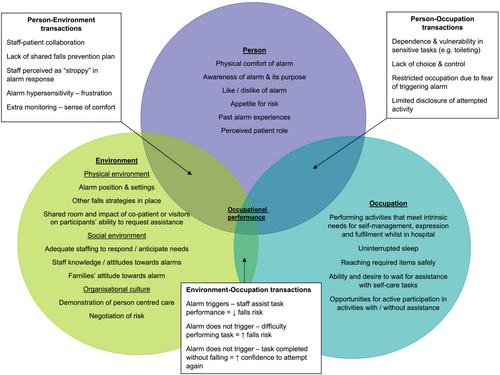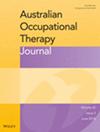The experiences of older adults with cognitive impairment in using falls prevention alarms in hospital: A qualitative descriptive study
Abstract
Introduction
Bed and chair sensor alarms are commonly used for falls prevention in hospitals, despite questionable efficacy. Research analysing older adults' experiences of alarms is scarce, and adults with cognitive impairment are consistently excluded.
Aim
The aim of this study was to explore how older adults with cognitive impairment perceive and experience falls prevention alarms in hospital.
Method
A qualitative descriptive design investigated older adults' experiences of alarms in a Geriatric Evaluation and Management ward in Melbourne. Patients were included if they had been provided an alarm. Semi-structured interviews were the primary method of data collection with two observation sessions and medical record analyses completed to enable triangulation of findings. Data were subjected to thematic analysis, and the Person-Environment-Occupation framework was chosen to add insight into the complexities of older adults' experiences of alarms.
Findings
All 11 participants had a level of cognitive impairment with delirium, confusion, or impulsiveness recorded in their medical file. Two overarching themes were identified: communication and collaboration with staff and rationalisation of alarm use. Participants' perceived staff were focussed on falls prevention but experienced a lack of communication about the purpose of alarms. Participants wanted an individualised approach to alarms. Some were comforted with the thought of alarms alerting staff, making them feel well cared for and believed alarms were a useful ‘back-up’. Others found alarms uncomfortable, frustrating, and restricting. Application of the Person-Environment-Occupation framework provided insight into how enabling and restrictive factors can impact whether the alarm is experienced positively or negatively. Seven unwitnessed falls occurred during the participants' admissions. Thirty-four per cent of alarm triggers observed were considered false alerts.
Conclusion
Older adults commonly reported negative experiences using bed/chair sensor alarms. Occupational therapists have the training to collaborate with people with cognitive impairment and assess the usefulness of alarms in reducing falls, based on how they interact with the older adult's unique person, environment, and occupation domains.


 求助内容:
求助内容: 应助结果提醒方式:
应助结果提醒方式:


